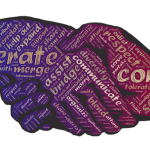 By Heidi Thiel
By Heidi Thiel
Communicating with coworkers isn’t always easy. Every employee has a different way of expressing themselves based on their upbringing, their personality, and their previous, or lack of, job experience.
When multiple generations must work together to achieve a common goal, it can become even more difficult to succeed because communication blocks increase. Technology plays a significant role in why generational communication tactics are so varied. Older generations also have different core values than younger generations.
It’s essential for employees of all ages to understand and respect one another’s ways of thinking if they hope to unite as one solid workforce. All employees must compromise and communicate effectively if they hope to move forward and feel confident in their roles.
Understanding the generations and their workplace values
Traditionalists are known as the Silent Generation, and they’re hard working and disciplined. Born before 1946, most Traditionalists are retired or nearing retirement; however, those who are still in the workforce often have a company-first mindset.
Baby Boomers, born between 1946 and 1964, are often workaholics. They value face-to-face communication, team projects, and harness the “anything is possible” mindset at work.
People born between 1965 and 1976 are members of Generation X, and Gen X employees need structure and direction in the workplace. They’re self-reliant and value flexibility, but they also ask many questions.
Millennials, born between 1977 and 1995, comprise the largest percentage of the current work population. Millennials are creative, good at multi-tasking, high-achievers, and self-confident. They prefer to communicate through email or text and they’re both efficient and ambitious.
Finally, we have the question of who is Gen Z? Born between 1996 and now, Gen Z is the most recent generation to enter the workforce. They’re still developing their communication style because they’re less experienced than other employees; however, they prefer having a mentor and taking on jobs that feel fulfilling. Similar to Millennials, Generation Z employees like to communicate using technology, such as text and FaceTime.
Respecting the varying experiences of other generations
All employees can have trouble understanding the preferences of their older or younger coworkers. For example, an older employee may never understand why a younger employee prefers emailing as opposed to talking to someone face-to-face. Alternatively, a younger employee may never understand why an older employee doesn’t see the value in a flexible work schedule.
Although employees may not understand the differences in generational workplace values, it’s essential for them to notice their differences and respect each other regardless of those differences. If two employees are having a communication issue and can pinpoint that the issue is stemming from a generational difference, then they can work towards a compromise.
Compromising to achieve a collective company goal
Compromising is the key to achieving the collective goal or mission of the company. Employees of all ages can miscommunicate, but ultimately, they must compromise if they hope to come together and grow as a whole.
Various strategies employees can be used to communicate effectively with one another. These strategies will span across generations and bridge any gaps that may arise.
Examples of effective communication tactics appreciated by all employees
Some effective communication tactics that employees of all ages can appreciate include being empathetic towards one another, actively listening to one another, having a more relaxed and welcoming body language, avoiding technological communication when serious issues arise, and being clear and confident in the delivery of a message.
If you take time to think about what you’re trying to communicate, who you’re communicating with, and how the best way to communicate your message would be, then you can more easily talk to anyone you work with.
_________
Heidi Thiel is a writer and content creator based in New York City, with a focus on wellness, mental health, business, and workplace subjects. When she’s not writing, you can find her exploring a new area of the city or hanging out with her bearded dragon. Take a look at her recent post to learn more about intergenerational communication in the workplace.
